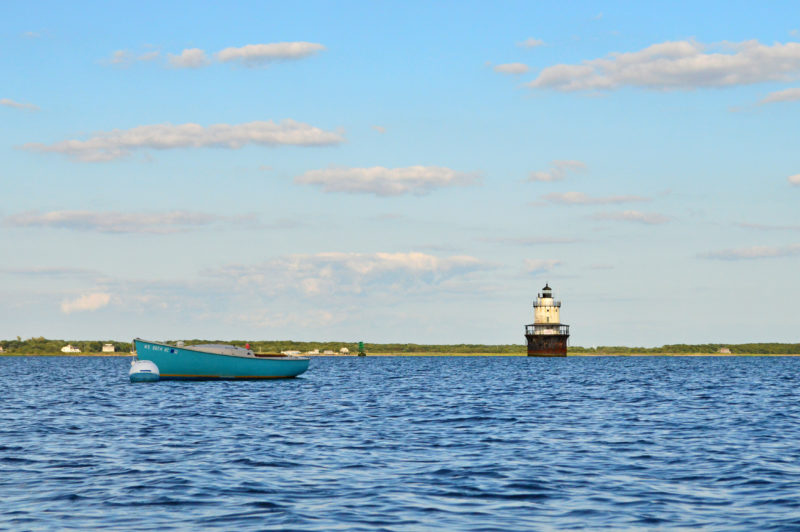Summer 2019 water quality declined slightly throughout Buzzards Bay
Water quality conditions measured in Buzzards Bay last summer offer a stark reminder about the impact of land development, outdated infrastructure, and climate change on the health of the Bay, according to data collected by the Buzzards Bay Coalition. A majority of locations around the Bay showed slight declines in water quality during the summer of 2019.
Each week in summer, the Coalition’s volunteer corps of Baywatchers collect water quality data at more than 200 monitoring stations on 30 major harbors, coves, and rivers across Buzzards Bay. These trained volunteers measure temperature, salinity, water clarity, dissolved oxygen, and general weather conditions. This data is combined with laboratory analysis of nitrogen and chlorophyll levels by the Marine Biological Laboratory in Woods Hole. These two data sets are combined to produce the Bay Health Index, which scores the health of harbors, coves, and rivers from 0 to 100. To find out how your favorite corner of the Bay is doing, visit savebuzzardsbay.org/bayhealth.
[LISTEN: Public radio reporter Eve Zuckoff from WCAI talked with Coalition Science Director Rachel Jakuba about the Bay Health index. Her report is available at the WCAI website.]
Overall, about 37 percent of Buzzards Bay’s waterways are now considered healthy, with “good” Bay Health scores. These waters are characterized by clear waters with visibility greater than six feet deep and high dissolved oxygen levels that allow fish and shellfish to thrive. Another 47 percent of waterways are in “fair” condition. In these areas, algal blooms grow causing cloudy water that makes eelgrass beds become sparse or completely disappear and dissolved oxygen levels periodically drop. The number of waterways in “poor” health, that are severely impacted by too much pollution resulting in murky waters and unhealthy underwater habitats, ticked up slightly to 16 percent.
“This year’s data include measurements that were taken shortly after a major rainfall last July that washed elevated levels of nitrogen pollution into the Bay,” said Dr. Rachel Jakuba, the Coalition’s science director.
Heavy rain storms increase nitrogen pollution in the Bay in two ways—through stormwater runoff from properties throughout the region and by overloading wastewater treatment systems that serve our area’s most populated communities. Stormwater runoff washes nitrogen and phosphorus pollutants from failing wastewater systems, fertilizers, and hard surfaces—buildings, parking lots, and roads—directly into the Bay. Heavy rainfall moves the nitrogen quickly in the Bay, short-circuiting the natural processes that remove nitrogen as it percolates from soils or is absorbed by wetland plants. In addition, combined sewer overflows in New Bedford discharge excess untreated sewage directly to nearby streams, rivers or other water bodies.
Water quality tests taken last July followed a two-day storm on July 23 and 24 that left between two to three inches of rain throughout the region. An intense storm, such as the one experienced last year, significantly increases pollution in the Bay over the short term. The effect of that event led to a decline in Bay Health index, albeit a modest decline, because the scores reflect a five-year average.
 Heavy rains delivering huge amounts of runoff to the Bay are expected to be an increasing problem for water quality in the years ahead as climate change increases the frequency and intensity of storms.
Heavy rains delivering huge amounts of runoff to the Bay are expected to be an increasing problem for water quality in the years ahead as climate change increases the frequency and intensity of storms.
The 2019 Bay Health results, however, also demonstrate the potential for reducing human impacts on the Bay. New Bedford Harbor, for example, continues to show gains in water quality that reflect the city’s efforts to remove combined sewer overflows from its wastewater system. While not yet eliminated, the work that has been done so far has resulted in noticeable improvements in the outer harbor and stabilized readings for the inner harbor, both of which are classified as being in “fair” health.
“While the high nitrogen levels in many places following the July rainstorm showed the often negative impacts of development on water quality, the 2019 data also show the potential for smart development to have a beneficial impact on water quality” Jakuba said.
The vast majority of nitrogen pollution to Buzzards Bay comes from traditional home septic systems and wastewater treatment plants. Although weather can play a big role in year-to-year changes in the Bay’s health, the largest long-term improvements will happen when we continue to reduce nitrogen from wastewater.
 Red Brook Harbor in Pocasset demonstrates what can be accomplished by improving wastewater treatment. A private wastewater system that removes nitrogen from the water was built to support a condominium development as well as Kingman Marina and its associated businesses. Since the wastewater plan began its operation, the water quality scores throughout the harbor have climbed, and the outer harbor’s health is now classified as “good,” the result of several years of improved water quality.
Red Brook Harbor in Pocasset demonstrates what can be accomplished by improving wastewater treatment. A private wastewater system that removes nitrogen from the water was built to support a condominium development as well as Kingman Marina and its associated businesses. Since the wastewater plan began its operation, the water quality scores throughout the harbor have climbed, and the outer harbor’s health is now classified as “good,” the result of several years of improved water quality.
The Coalition is spearheading a regional collaboration among the upper Bay communities in Wareham, Bourne, Plymouth and Marion that aims to substantially reduce the amount of nitrogen discharged into the Bay. The project would connect more homes to the Wareham wastewater treatment plant, which removes as much as 95 percent of nitrogen from its treated wastewater. First, however, the plant’s discharge pipe must be relocated from the Agawam River to a less-sensitive location.
Local residents are also making a difference to reduce nitrogen pollution from septic systems. From Westport to West Falmouth, property owners are upgrading to nitrogen-reducing septic systems through a program organized by the Coalition. The effort, which provides funding and technical support for homeowners to upgrade their septic systems, has resulted in the installation of more than 30 of these systems.
These efforts to reduce nitrogen pollution from wastewater around Buzzards Bay will drive long-term water quality improvements. When the baseline water quality is higher, the Bay ecosystem will be able to better handle short-term pulses of nitrogen input from rain storms.